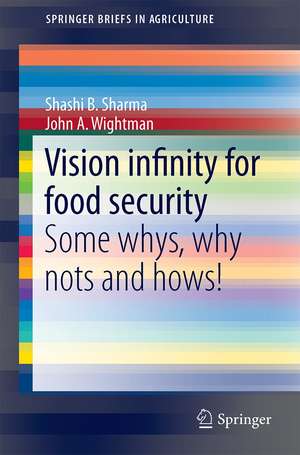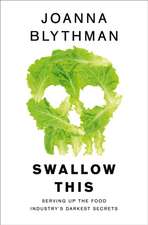Vision Infinity for Food Security: Some Whys, Why Nots and Hows!: SpringerBriefs in Agriculture
Autor Shashi B. Sharma, John A. Wightmanen Limba Engleză Paperback – 15 sep 2015
Din seria SpringerBriefs in Agriculture
-
 Preț: 381.00 lei
Preț: 381.00 lei -
 Preț: 355.49 lei
Preț: 355.49 lei -
 Preț: 376.43 lei
Preț: 376.43 lei -
 Preț: 348.72 lei
Preț: 348.72 lei -
 Preț: 377.18 lei
Preț: 377.18 lei -
 Preț: 379.30 lei
Preț: 379.30 lei -
 Preț: 376.22 lei
Preț: 376.22 lei - 15%
 Preț: 462.05 lei
Preț: 462.05 lei -
 Preț: 376.04 lei
Preț: 376.04 lei -
 Preț: 388.24 lei
Preț: 388.24 lei -
 Preț: 343.51 lei
Preț: 343.51 lei -
 Preț: 379.68 lei
Preț: 379.68 lei -
 Preț: 375.45 lei
Preț: 375.45 lei -
 Preț: 377.18 lei
Preț: 377.18 lei -
 Preț: 374.30 lei
Preț: 374.30 lei
Preț: 355.07 lei
Nou
Puncte Express: 533
Preț estimativ în valută:
67.94€ • 72.65$ • 56.65£
67.94€ • 72.65$ • 56.65£
Carte tipărită la comandă
Livrare economică 14-21 aprilie
Preluare comenzi: 021 569.72.76
Specificații
ISBN-13: 9783319232485
ISBN-10: 3319232487
Pagini: 150
Ilustrații: XVII, 98 p. 8 illus., 6 illus. in color.
Dimensiuni: 155 x 235 x 7 mm
Greutate: 0.24 kg
Ediția:1st ed. 2015
Editura: Springer International Publishing
Colecția Springer
Seria SpringerBriefs in Agriculture
Locul publicării:Cham, Switzerland
ISBN-10: 3319232487
Pagini: 150
Ilustrații: XVII, 98 p. 8 illus., 6 illus. in color.
Dimensiuni: 155 x 235 x 7 mm
Greutate: 0.24 kg
Ediția:1st ed. 2015
Editura: Springer International Publishing
Colecția Springer
Seria SpringerBriefs in Agriculture
Locul publicării:Cham, Switzerland
Public țintă
ResearchCuprins
1: Introduction.- 2: Is there enough food?.- 3: Food security – how did we get to where we are now?.- 4: Are there fundamental constraints to food security?.- 5: Biosecure global food value chains.- 6: Exploit additional food sources.- 7: Eliminate food losses.- 8: Rethinking agro-ecosystems and diversity with farming systems.- 9: In search of answers – tying it all together.- 10: Way forward.
Notă biografică
Professor and Chair Shashi Sharma I am currently engaged in establishing a Centre for Biosecurity and Food Security at Murdoch University. This Centre is unique in that no other research centre in the world has mandated biosecurity as an integral component of global food security. The Centre offers a new paradigm of research through the food value chains across the terrestrial and aquatic food sectors including food trade and distribution. The paradigm calls for integration of biological, chemical, engineering and social sciences to deliver research outputs. The three key research themes of the Centre (3Ps) are: Produce food sustainably (P1);Protect food from loss and waste in the value chain (P2); and, Provide bio-secure, safe and nutritious food (P3). Murdoch University has existing strengths in the P1 theme, and has identified a need for capability enhancement in the P2 and P3 themes to develop new tools and technologies for post-harvest food loss and food waste management, managingchemical contaminants, food safety, and innovative technologies for improved market access and trade.
Textul de pe ultima copertă
This book builds on authors’ perspective on food security gathered from their global experience of working with farmers in their fields. They are standing back and looking at the global food security situation as a whole through squinted eyes and are concerned about vulnerability and fragility of food value chains. Our species has developed incredible technology, but our heads are in the sand when it comes down to the fundamentals of our survival as a species. The destruction through over exploitation of natural environments, pollution of all kinds, the ensuing impacts of climate change are putting our ability to garner food and potable water from our environment. The issue of food security and the consequences of its absence are becoming more pressing. In many parts of the world, insufficient food is grown to provide adequate nutrition for everyone, every day. Food is lost to pests before harvest and after harvest. Too much is wasted between field and mouth. New paradigms are needed; old ones need to be discarded. The human population is set to number 10 billion by 2052, and to keep on increasing. Can that number of people be fed and if not – what are the constraints? The 10 chapters in this book discuss the current situations, explore options and consider solutions. In a rapidly urbanized and cyber-technology dependent modern world, the global food security challenge is to provide safe and nutritious food to all in the face of population growth and the preservation of natural ecosystems. The response to this challenge must include improving the efficiency of the food chain with technological and market innovation that enable billions of smallholder farmers access the value chain and scale up income generating activities. Long term vision has been missing from our food security planning and inter-generational perspective. Efficient agricultural production that takes advantage of innovative technologies underpinned by end-to-end value-chain development from promoting the right inputs to encouraging mass adoption of balanced and nutritive food intake will be the real progress towards food security for all.
Caracteristici
Applies novel approach and vision to examine the global food security issue Highlights the need for considering biosecurity as an integral part of global food security strategy Recommends adoption of a ‘3Ps Mantra’ to transform the current global emphasis on ‘producing more food’ to ‘whole of food value chain’ for achieving sustainable global food security for the present and future generations Explores new answers for enhancing availability of nutritious food for the present and future generations Includes supplementary material: sn.pub/extras









